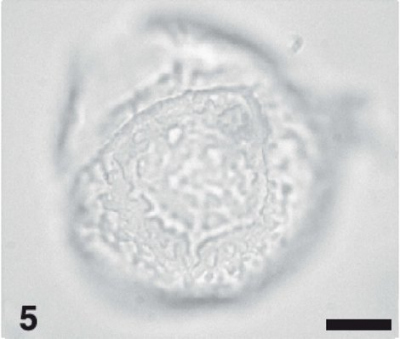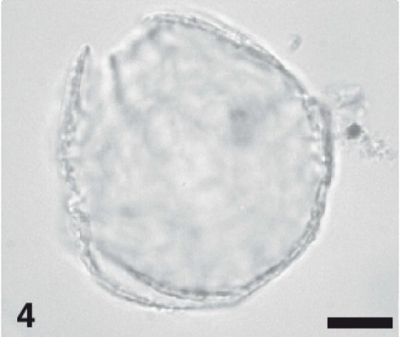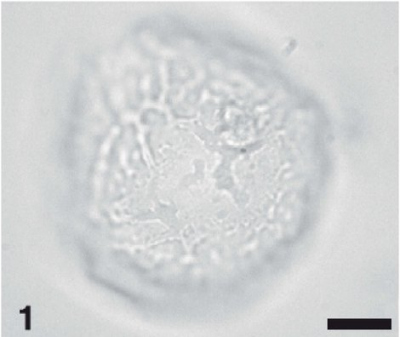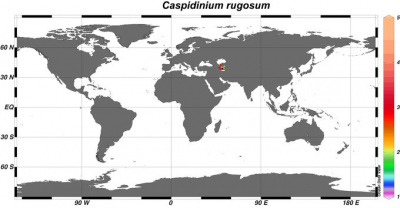Die Inhalte dieser Seite sind leider nicht auf Deutsch verfügbar.
Seitenpfad:
- Modern Dinocyst Key
- transparent cysts
- Paratabulation reflected by septa
- variable septa
- Caspidinium rugosum
Caspidinium rugosum
Zonneveld, K.A.F. and Pospelova V. (2015). A determination key for modern dinoflagellate cysts. Palynology 39 (3), 387- 407.

dorsal view

cross section

ventral view
photographs from: Marret et al., 2004, Review of palaeobotany and Palynology, 129, 1 - 20.
scale bar 10 micron meter
scale bar 10 micron meter
Field Characteristics
Caspidinium rugosum Marret et al 2004.
Field Characteristics:
Proximate cyst with S-type ventral tabulation of spherical to slightly cruciform shape. Tabulation is expressed by low and broad sutural septa with dextral torsion with exception of the sulcal area. The relatively thick wall is coarsely granulate to papillate. Archeopyle is precingular (type P).
Dimensions: Cyst Body: 45 – 60 μm. cyst wall: 1.5 μm.
Motile affinity: unknown
Stratigraphic range: Recent
Comparison with other species:
C. rugosum has low irregularly formed septa that may complete or only partly reflect the sutures. Since the cyst wall is coarsely granulated, pappilated to verrucated. The tabulation can not be easily observed on some parts of the cyst. The completeness of the tabulation, the height of the septa and wall structure can vary considerably between specimens. This species is easy to distinguish from Impagidinium cysts by its irregular, often not complete reflection of the sutures and presence of solid septa.
Field Characteristics:
Proximate cyst with S-type ventral tabulation of spherical to slightly cruciform shape. Tabulation is expressed by low and broad sutural septa with dextral torsion with exception of the sulcal area. The relatively thick wall is coarsely granulate to papillate. Archeopyle is precingular (type P).
Dimensions: Cyst Body: 45 – 60 μm. cyst wall: 1.5 μm.
Motile affinity: unknown
Stratigraphic range: Recent
Comparison with other species:
C. rugosum has low irregularly formed septa that may complete or only partly reflect the sutures. Since the cyst wall is coarsely granulated, pappilated to verrucated. The tabulation can not be easily observed on some parts of the cyst. The completeness of the tabulation, the height of the septa and wall structure can vary considerably between specimens. This species is easy to distinguish from Impagidinium cysts by its irregular, often not complete reflection of the sutures and presence of solid septa.
Geographic Distribution
Geographic distribution based on :
Zonneveld et al., 2013. Atlas of modern dinoflagellate cyst distribution based on 2405 datapoints. Review of Palaeobotany and Palynology, v. 191, 1-197
Zonneveld et al., 2013. Atlas of modern dinoflagellate cyst distribution based on 2405 datapoints. Review of Palaeobotany and Palynology, v. 191, 1-197
Caspidinium rugosum is endemic for the Caspian Sea and is observed in regions where reduced salinities, oligotrophic conditions and well ventilated bottom waters prevail.

Distribution:
C. rugosum is restricted to the Caspian Sea where it accounts for up to 4.4% of the association.
Environmental parameter range:
SST: 4.7 - 24.4°C (winter -summer), SSS: 11.2 - 13.3, [P]: 0.1 - 0.4 μmol/l, [N]: 0.1 - 0.3 μmol/l, chlorophyll-a: 1.4 - 1.7 ml/l, bottom water [O2]: 6.5 - 6.7 ml/l.
Nutrient concentrations are low at these sites whereas bottom waters are well ventilated.
Comparison with other records:
It is not registered from regions other than covered by this Atlas.
C. rugosum is restricted to the Caspian Sea where it accounts for up to 4.4% of the association.
Environmental parameter range:
SST: 4.7 - 24.4°C (winter -summer), SSS: 11.2 - 13.3, [P]: 0.1 - 0.4 μmol/l, [N]: 0.1 - 0.3 μmol/l, chlorophyll-a: 1.4 - 1.7 ml/l, bottom water [O2]: 6.5 - 6.7 ml/l.
Nutrient concentrations are low at these sites whereas bottom waters are well ventilated.
Comparison with other records:
It is not registered from regions other than covered by this Atlas.


